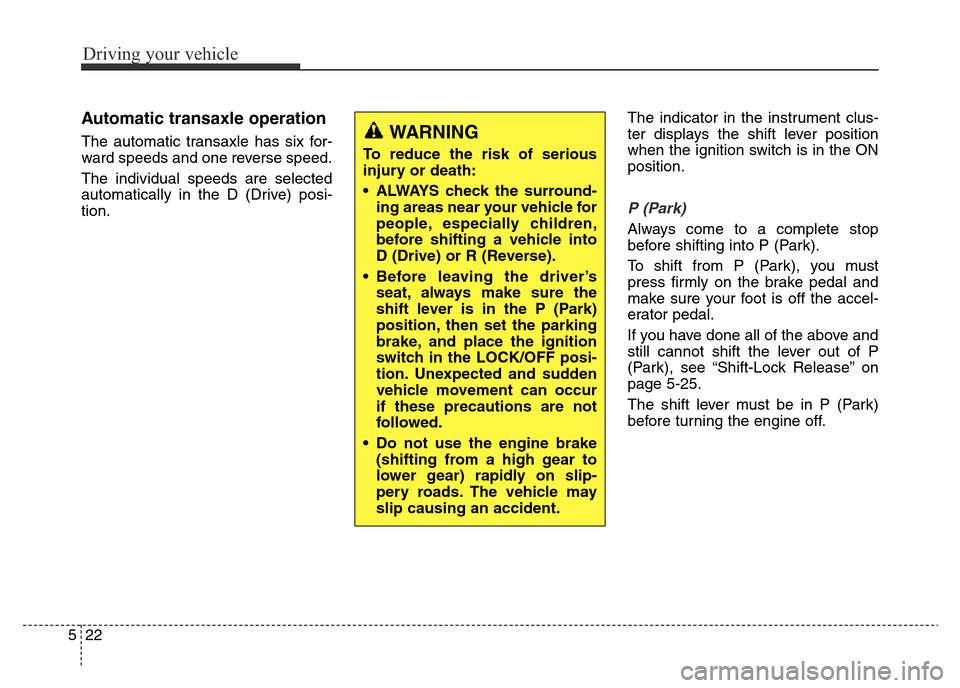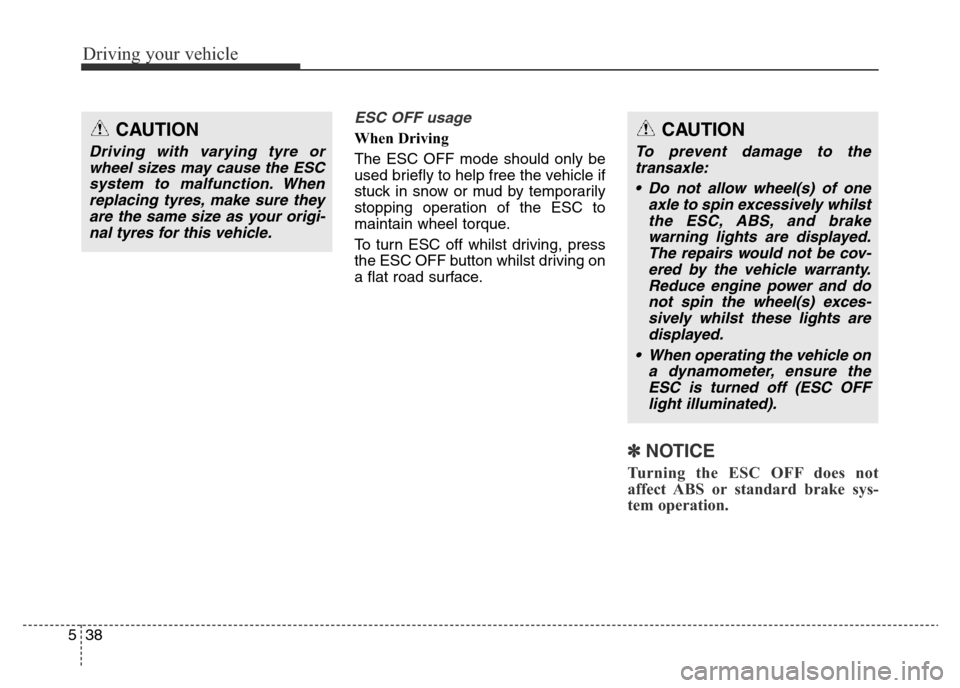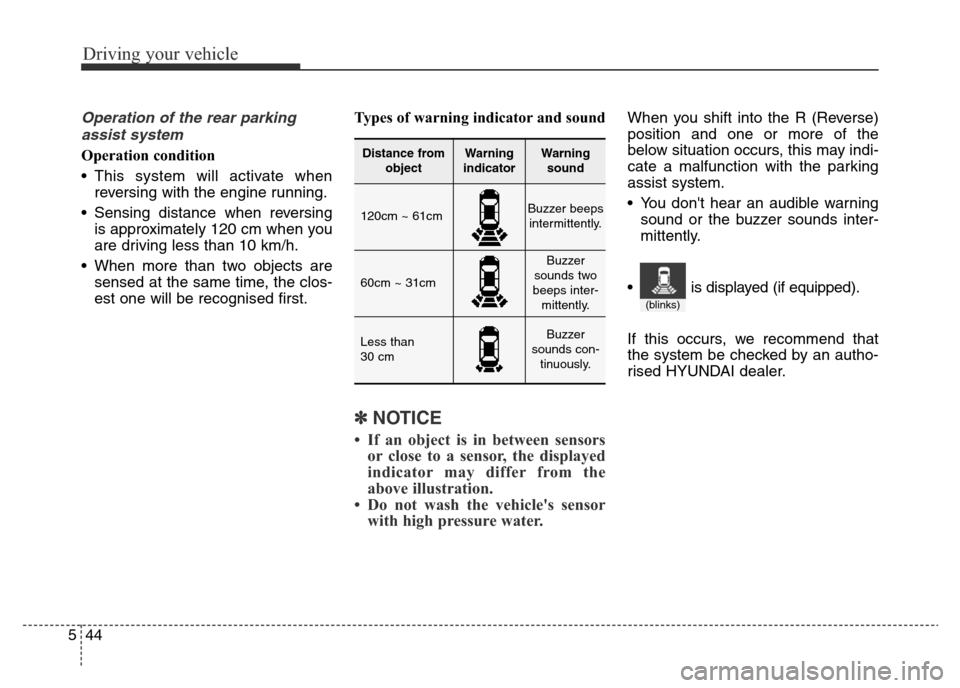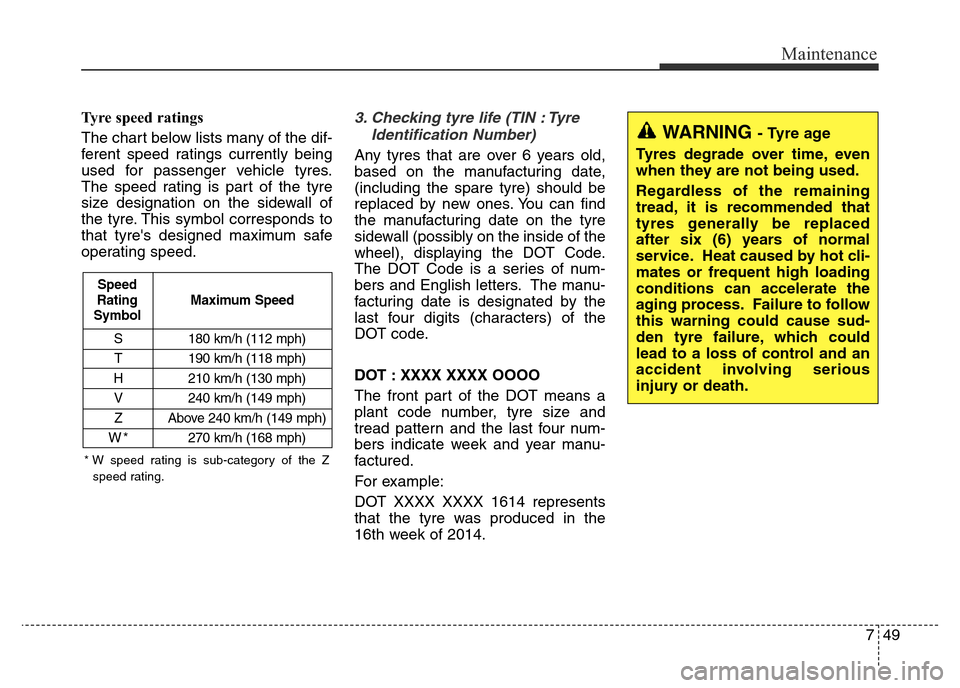Page 326 of 498

Driving your vehicle
22 5
Automatic transaxle operation
The automatic transaxle has six for-
ward speeds and one reverse speed.
The individual speeds are selected
automatically in the D (Drive) posi-
tion.The indicator in the instrument clus-
ter displays the shift lever position
when the ignition switch is in the ON
position.
P (Park)
Always come to a complete stop
before shifting into P (Park).
To shift from P (Park), you must
press firmly on the brake pedal and
make sure your foot is off the accel-
erator pedal.
If you have done all of the above and
still cannot shift the lever out of P
(Park), see “Shift-Lock Release” on
page 5-25.
The shift lever must be in P (Park)
before turning the engine off.
WARNING
To reduce the risk of serious
injury or death:
• ALWAYS check the surround-
ing areas near your vehicle for
people, especially children,
before shifting a vehicle into
D (Drive) or R (Reverse).
• Before leaving the driver’s
seat, always make sure the
shift lever is in the P (Park)
position, then set the parking
brake, and place the ignition
switch in the LOCK/OFF posi-
tion. Unexpected and sudden
vehicle movement can occur
if these precautions are not
followed.
• Do not use the engine brake
(shifting from a high gear to
lower gear) rapidly on slip-
pery roads. The vehicle may
slip causing an accident.
Page 342 of 498

Driving your vehicle
38 5
ESC OFF usage
When Driving
The ESC OFF mode should only be
used briefly to help free the vehicle if
stuck in snow or mud by temporarily
stopping operation of the ESC to
maintain wheel torque.
To turn ESC off whilst driving, press
the ESC OFF button whilst driving on
a flat road surface.
✽NOTICE
Turning the ESC OFF does not
affect ABS or standard brake sys-
tem operation.
CAUTION
Driving with varying tyre or
wheel sizes may cause the ESC
system to malfunction. When
replacing tyres, make sure they
are the same size as your origi-
nal tyres for this vehicle.
CAUTION
To prevent damage to the
transaxle:
• Do not allow wheel(s) of one
axle to spin excessively whilst
the ESC, ABS, and brake
warning lights are displayed.
The repairs would not be cov-
ered by the vehicle warranty.
Reduce engine power and do
not spin the wheel(s) exces-
sively whilst these lights are
displayed.
• When operating the vehicle on
a dynamometer, ensure the
ESC is turned off (ESC OFF
light illuminated).
Page 348 of 498

Driving your vehicle
44 5
Operation of the rear parking
assist system
Operation condition
• This system will activate when
reversing with the engine running.
• Sensing distance when reversing
is approximately 120 cm when you
are driving less than 10 km/h.
• When more than two objects are
sensed at the same time, the clos-
est one will be recognised first.Types of warning indicator and sound
✽NOTICE
• If an object is in between sensors
or close to a sensor, the displayed
indicator may differ from the
above illustration.
• Do not wash the vehicle's sensor
with high pressure water.
When you shift into the R (Reverse)
position and one or more of the
below situation occurs, this may indi-
cate a malfunction with the parking
assist system.
• You don't hear an audible warning
sound or the buzzer sounds inter-
mittently.
If this occurs, we recommend that
the system be checked by an autho-
rised HYUNDAI dealer.
Distance from
objectWarning
indicatorWarning
sound
120cm ~ 61cmBuzzer beeps
intermittently.
60cm ~ 31cm
Buzzer
sounds two
beeps inter-
mittently.
Less than
30 cmBuzzer
sounds con-
tinuously.
(blinks)
• is displayed (if equipped).
Page 350 of 498
Driving your vehicle
46 5
Parking assist system
(if equipped)The Parking Assist System aids the
driver during movement of the vehi-
cle by chiming or displaying the area
if any object is sensed within the dis-
tance of about 100 cm in front or 120
cm behind the vehicle. This is a sup-
plemental system that senses
objects within the range and location
of the sensors. It cannot detect
objects in other areas where sensors
are not installed.
OMD044163
OMD044090
■Front sensor
■Rear sensor
Sensors
Sensors
WARNING
• ALWAYS look around your
vehicle to make sure there are
no objects or obstacles
before moving the vehicle in
any direction to prevent a col-
lision.
• Always pay close attention
when the vehicle is driven
close to objects, particularly
pedestrians, and especially
children.
• Be aware that some objects
may not be detected by the
sensors, due to the objects
distance, size or material, all
of which can limit the effec-
tiveness of the sensor.
Page 352 of 498
Driving your vehicle
48 5
When you shift into the R (Reverse)
position and one or more of the
below situation occurs, this may indi-
cate a malfunction with the parking
assist system.
• You don't hear an audible warning
sound or the buzzer sounds inter-
mittently.
If this occurs, we recommend that
the system be checked by an autho-
rised HYUNDAI dealer.
Distance from object
Warning indicator
Warning soundWhen driving
forwardWhen driving
rearward
100cm~61cmFront-Buzzer beeps
intermittently
120cm~61cmRear-Buzzer beeps
intermittently
60cm~31cm
FrontBuzzer beeps
frequently
Rear-Buzzer beeps
frequently
Less than
30 cmFrontBuzzer sounds
continuously
Rear-Buzzer sounds
continuously
Types of warning indicator and sound
✽NOTICE
• The actual warning sound and indicator may differ from the illustration
according to objects or sensor status.
• Do not wash the vehicle's sensor with high pressure water.
• is displayed (if equipped).
(blinks)
Page 369 of 498

565
Driving your vehicle
For New Zealand
Towing Capacity Note
The recommended towing capacity of this vehicle will be provided with the
Genuine
HYUNDAIApproved Tow Bar.
• To enquire about the towing capacity of this vehicle, please visit
www
.hyundai.co.nz, or call us on 0800 HYUNDAI.
• To enquire about Genuine HYUNDAI parts and accessories (including the
Genuine HYUNDAI Approved Tow Bar and its availability for purchase)
please consult your nearest authorised HYUNDAI dealer/service agent,
call us on 0800 HYUNDAI or visit www
.hyundai.co.nz.
It is the owner's responsibility to ensure that any tow bar used is compatible
with and suitable for their vehicle, and is within the towing capacity of their
vehicle. Your HYUNDAI vehicle should not be used to tow heavy loads
beyond the recommended towing capacities displayed on
www
.hyundai.co.nzas it is not designed for such use.
Subject to applicable law, HYUNDAI Motors New Zealand Ltd shall not be
liable for any losses, damages, costs, expenses (including but not limited to
consequential and indirect losses, personal injury and deaths) caused by
towing which is not in compliance with instructions set out in the owner's
manual.
WARNING
HYUNDAI DO NOT recommend
the use of load levelling devices
of any type. The use of a load
levelling devices may place
undue stress on the chassis
causing chassis or mounting
point failure.
Page 444 of 498

749
Maintenance
Tyre speed ratings
The chart below lists many of the dif-
ferent speed ratings currently being
used for passenger vehicle tyres.
The speed rating is part of the tyre
size designation on the sidewall of
the tyre. This symbol corresponds to
that tyre's designed maximum safe
operating speed.3. Checking tyre life (TIN : Tyre
Identification Number)
Any tyres that are over 6 years old,
based on the manufacturing date,
(including the spare tyre) should be
replaced by new ones. You can find
the manufacturing date on the tyre
sidewall (possibly on the inside of the
wheel), displaying the DOT Code.
The DOT Code is a series of num-
bers and English letters. The manu-
facturing date is designated by the
last four digits (characters) of the
DOT code.
DOT : XXXX XXXX OOOO
The front part of the DOT means a
plant code number, tyre size and
tread pattern and the last four num-
bers indicate week and year manu-
factured.
For example:
DOT XXXX XXXX 1614 represents
that the tyre was produced in the
16th week of 2014.
S 180 km/h (112 mph)
T 190 km/h (118 mph)
H 210 km/h (130 mph)
V 240 km/h (149 mph)
Z Above 240 km/h (149 mph)
W*270 km/h (168 mph)
Maximum Speed Speed
Rating
Symbol
* W speed rating is sub-category of the Z
speed rating.
WARNING - Tyre age
Tyres degrade over time, even
when they are not being used.
Regardless of the remaining
tread, it is recommended that
tyres generally be replaced
after six (6) years of normal
service. Heat caused by hot cli-
mates or frequent high loading
conditions can accelerate the
aging process. Failure to follow
this warning could cause sud-
den tyre failure, which could
lead to a loss of control and an
accident involving serious
injury or death.